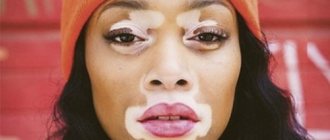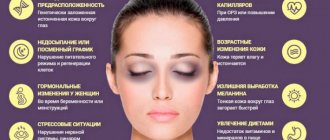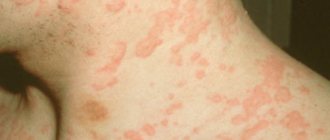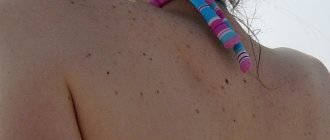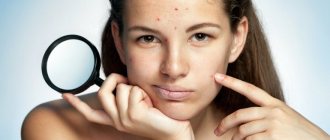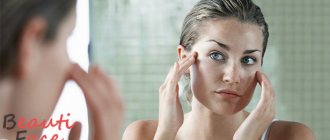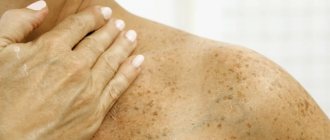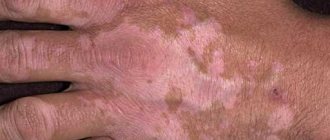Issues discussed in the material:
- Why spots may appear on the body as we age
- What types of age spots are there?
- What does the color of spots on the skin of an elderly person indicate?
- How to diagnose a disease associated with hyperpigmentation in old age
- How can you get rid of age spots?
Those who think that in old age a person does not care what he looks like are mistaken. Men, and even more so women, worry about seeing wrinkles and want to stay in shape even at forty-five years old, even at sixty. But over the years, the smoothness of the skin decreases, and dark spots begin to appear in older people. We will analyze in the article what is the reason for their occurrence and what methods are available to combat this defect.
Reasons for appearance
Why spots may appear:
- The main reason is age , but there are a large number of factors that contribute to the appearance of age spots. They can occur even in those who have never had skin problems.
- The formation of age-related pigmentation is influenced by heredity, conditions and lifestyle . If a person lives in a polluted environment, then over time the body begins to accumulate toxins. They cease to be excreted using internal organs. As a result of such processes, senile plaques appear on the skin.
- One of the most important factors is frequent sunbathing . Active sun rays have a negative effect on the condition of the skin. As a result, there is an imbalance in the production of melatonin, and as a result, brown spots are formed.
- Deficiency of vitamin C and PP can cause such a deviation. Sometimes dark age spots occur against the background of a disease of the internal organs.
The most common skin diseases of older people and their treatment
1.Skin itching.
This is one of the most common problems. Itchy skin in an older person can be due to a number of different reasons. It's difficult to name just one. This can be a localized or generalized disease. Constant dryness, dehydration, and skin diseases cause a localized appearance. The generalized type is caused by frequent exposure to the sun, sudden temperature changes, parasitic and somatic diseases. Also, its causes include constant washing of the skin with soap.
Possible causes of itching in older people:
- sclerosis;
- tumors in organs;
- polycythemia;
- mucous swelling;
- hyperglycemia;
- diabetes insipidus;
- tabes dorsalis;
- shingles;
- inflammation of the gallbladder;
- cholestatic syndrome;
- the presence of stones in the bile ducts;
- inflammation of the pancreas;
- chronic kidney failure;
- hyperthyroidism;
- hypothyroidism;
- diseases affecting lymphatic tissue;
- multiple myeloma;
- lack of iron in the body;
- lupus erythematosus;
- biliary cirrhosis;
- various types of hepatitis;
- parasitic diseases;
- rheumatoid arthritis;
- brain tumors;
- pathologies associated with the psyche.
- Recommended articles to read:
- Fractures in the elderly: treatment, recovery and prevention
- Caring for the elderly: valuable tips and range of services
- Features of older people: psychological, physiological and social
If no diseases from the above list are found, then the patient is most likely diagnosed with senile itching. This means the need for constant medical monitoring, because such an ailment can be a harbinger of those same pathologies, even if they have not yet been identified. Treatment of itchy skin in older people begins with a full examination: you need to take biochemical and clinical tests of blood, urine, feces, check the thyroid gland, and take a chest x-ray.
Despite the fact that the doctor will prescribe medications for an elderly person to reduce pain, it is necessary to understand the true cause of the disease and try to eliminate it. If the itching is localized, the patient will be prescribed corticosteroid drugs for external use, universal - for oral use. Possible side effects and chronic diseases, such as diabetes, hypertension, osteoporosis, limit the intake of corticosteroids orally.
The doctor may also prescribe first-generation antihistamines with a sedative effect, such as tavegil, diazolin, suprastin, together with calcium supplements or antidepressants. It is best to choose weak local corticosteroid agents, as they can cause increased skin atrophy. 1% hydrocortisone ointment is best. Calming medications containing menthol and cold compresses will also help relieve pain.
Psychodermatological conditions.
Elderly people often suffer from all kinds of phobias. Basically, they are afraid of parasitic diseases. Elderly patients often complain that insects or worms are crawling on their skin, and to prove their case, they may even show off vessels containing supposedly removed parasites.
In an attempt to get rid of the disease on their own, old people injure themselves in the form of burns and infected wounds. As a rule, they do not trust medicine and perceive any therapy negatively. In addition, psychiatrists do not pay special attention to older people with such symptoms, forcing them to wander from one doctor to another in the hope of finding a competent specialist who can cure them of this infection.
3. Allergic dermatitis.
There are contact allergic dermatitis and those that arise due to general effects on the body.
The cause of the former is irritation caused by the use of detergents and cleaning products, as well as improper treatment of certain skin pathologies. The dermis becomes drier and thinner.
The cause of the second group of dermatitis includes the use of certain medications simultaneously. Most often this concerns older people with somatic illnesses, who are prescribed drugs without paying attention to their compatibility.
You can get rid of this disease with the help of antihistamines, such as tavegil, suprastin, diazolin. They must be taken in small doses before going to bed.
If infected wounds form on the skin due to severe itching, doctors prescribe a course of oral antibiotics, for example, hyoxysone, pimafucort and ointment for external use.
Due to the intake of certain incompatible medications, not only allergic dermatitis can occur, but also other skin diseases: urticaria, erythema multiforme. In such cases, a person is prescribed antihistamines, as well as non-steroidal anti-inflammatory drugs and regenerating ointments (videstim, radevit). If the symptoms affect the oral cavity, then the best way to relieve the unpleasant symptoms is by rinsing with the use of antiseptics. For this purpose, you can take furatsilin, miramistin, etc.
Xerosis, or dry skin.
Dry skin in older people is perhaps one of the most common problems. This is due to the fact that over time, the natural renewal of the dermis and exfoliation of horny scales stops, and therefore the rate of production of new epithelial cells decreases. As a result, the skin becomes too susceptible to irritation. In addition, the volume of water contained in the body decreases, since sphinlipids are responsible for its amount, the amount of which decreases with age.
To relieve irritation and promote hydration, topical treatments such as oils or creams are used for treatment. The latter are more practical and easy to apply, as they do not stain clothes and are better absorbed. It is better to choose a rich cream, as the effect will be more noticeable. If cosmetic products cause allergic reactions in a person, then it is worth replacing them with external medications, for example, Radevit or Videstim ointments.
Read material on the topic: Bedridden elderly person: care, feeding, hygiene
Types of pigmentation
Senile pigmentation can be of different types, each of them has its own characteristics and reasons for its appearance. The main types of age spots:
- xanthomas are yellow, oval-shaped formations that often appear not on the body, but in the area around the eyes;
- senile lentigo - spots with a clear boundary and different colors, localized in the hands and décolleté;
- senile keratomas are pale plaques with small scales and are benign in nature.
The appearance of any type of age-related pigmentation may indicate a malfunction of internal organs. The doctor will help diagnose the nature of the formations and prescribe treatment.
How to diagnose problems in the body?
The color, size and location of pigment spots can indicate the presence of pathological changes in the human body.
- Yellow plaques are most often present in overweight people. They indicate impaired metabolism and high cholesterol levels.
- Pigmentation around the mouth is a signal of the presence of polyps in the intestines or gastric tract.
- Brown plaques on the forearm on the back of the hands indicate liver problems.
- A large number of light spots indicates a lack of vitamins in the body.
If the cause of age-related pigmentation is diseases of the internal organs, then after treatment the spots go away on their own.
How to get rid of pigmentation on the skin?
There are a large number of ways to remove age spots from the skin . These can be home, salon cosmetic procedures and hardware effects. The treatment method is selected depending on the size of the formation and its location.
On the face
The skin on my face is quite sensitive. You should always test for an allergic reaction before using cosmetics or home remedies. The problem can be eliminated only with an integrated approach.
The first thing you should do is consult a doctor so that he can diagnose your internal organs. In most cases, age spots appear due to problems with the liver and kidneys. How to remove pigmentation on the face, remove spots or make them less noticeable? Salon procedures will help with this:
- Peels using fruit or ascorbic acid . This method will be effective only at the initial stage of the lesion. The procedure allows you to exfoliate and make the pigment lighter.
- Mesotherapy . Treatment is carried out by introducing special lightening solutions. The procedure will bring the desired effect only in the early stages of the lesion.
- Laser resurfacing . This method is prescribed to remove old stains. The effect is on the pigment. It is destroyed by a burn.
- Use of special cosmetic preparations . There are drugs that can inhibit the production of melanin. A cosmetologist may prescribe the use of masks with retinol.
How to get rid of pigmentation on the skin using folk remedies? One of the most effective methods for removing spots on the face is the use of potato-based products. Its tubers contain sugar and starch, which activate the skin renewal process. This product contains potassium, zinc, phosphorus and vitamin B6. These substances are necessary for the formation of collagen.
Age-related facial skin care
Some cosmetic procedures need to be done more often, others less often. In any case, you should be careful, watch the skin’s reaction, and take care of it.
Age-related facial skin care consists of the following points:
- Cleansing. Perform 2 times a day, use cotton pads.
- Toning massage. Ice cubes prepared with herbal infusions and sea water work well. Massage your face, neck, and décolleté along the massage lines for a few minutes a day.
- How to stop facial skin aging? Choose a good cream. It is advisable to have three types: day, night, for eyelids. On a box of day cream, and indeed in any skin care product, look for the label “sun protection”, vitamins B, E, hyaluron (the latter is added to cosmetic serums).
- For the skin of the eyelids, masks, lotions, and compresses are needed to strengthen muscles, tighten the skin, and improve lymph and blood flow.
- Home care is also required for the face, neck, décolleté, and hands.
Home treatments
To keep your skin from aging and to look attractive at any age (even with wrinkles!), it needs care. Masks can work real miracles. They can replace expensive cosmetic procedures without causing any harm.
Warm potato mask “3 zones”
Despite its simplicity, this is a very effective recipe. Wash and boil 2-3 potatoes without peeling the skin. Mash the tubers with a fork, dilute with warm milk to a comfortable thickness. Add the yolk. Mash the mixture thoroughly. Apply to face, eyelids, neck, décolleté.
Whitening mask with cucumber
Stop pigmentation with cucumber pulp. Grate the vegetable or chop it into circles. Distribute on face, neck. The cucumber does not hold well and drips. During the procedure, lie down with a towel under your head.
Nourishing yeast mask
Dissolve the yeast with warm milk and leave to ferment for 15-20 minutes. Add 1 teaspoon each of honey and flax oil. Mix thoroughly.
Super lifting
Mix potato starch and yolk. Try adding vitamin A and E to the mixture. Apply to your face. Keep for about 15 minutes. After the first layer has dried, you can apply 1-2 more.
Moisturizing with glycerin
Mix honey and glycerin (1:1). Apply the mask to your face. Glycerin can dry out the skin. To avoid unwanted effects, apply the mask in a room with high humidity.
Pea nutritional
Boil regular peas. Option - grind the peas into flour and pour boiling water over them, let it brew. Mix puree with heavy cream.
How to apply age masks
How to slow down skin aging using home remedies? Apply masks correctly.
- Keep the mixture for 20 minutes so that the beneficial components reach the deepest layers.
- Before the procedure, steam your face over a steam bath, apply a hot damp towel, and take a shower.
- Test new mixtures on the crook of your elbow - mature skin is prone to dermatitis.
- Rinse off the mixture carefully, do not rub your face.
- After the mask, apply nourishing cream.
